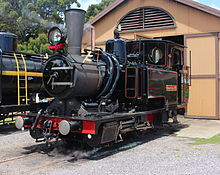
West Coast Wilderness Railway

| West Coast Wilderness Railway | |||||||||||||||||||||||||||||||||||||||||||||||||||||||||||||||||||||||||||||||||||||||||||||||||||||||||||||||||||||||||||||||||||||||||||||||||||
|---|---|---|---|---|---|---|---|---|---|---|---|---|---|---|---|---|---|---|---|---|---|---|---|---|---|---|---|---|---|---|---|---|---|---|---|---|---|---|---|---|---|---|---|---|---|---|---|---|---|---|---|---|---|---|---|---|---|---|---|---|---|---|---|---|---|---|---|---|---|---|---|---|---|---|---|---|---|---|---|---|---|---|---|---|---|---|---|---|---|---|---|---|---|---|---|---|---|---|---|---|---|---|---|---|---|---|---|---|---|---|---|---|---|---|---|---|---|---|---|---|---|---|---|---|---|---|---|---|---|---|---|---|---|---|---|---|---|---|---|---|---|---|---|---|---|---|---|
 | |||||||||||||||||||||||||||||||||||||||||||||||||||||||||||||||||||||||||||||||||||||||||||||||||||||||||||||||||||||||||||||||||||||||||||||||||||
| Locale | West Coast, Tasmania | ||||||||||||||||||||||||||||||||||||||||||||||||||||||||||||||||||||||||||||||||||||||||||||||||||||||||||||||||||||||||||||||||||||||||||||||||||
| Terminus | Queenstown and Strahan | ||||||||||||||||||||||||||||||||||||||||||||||||||||||||||||||||||||||||||||||||||||||||||||||||||||||||||||||||||||||||||||||||||||||||||||||||||
| Commercial operations | |||||||||||||||||||||||||||||||||||||||||||||||||||||||||||||||||||||||||||||||||||||||||||||||||||||||||||||||||||||||||||||||||||||||||||||||||||
| Original gauge | 3 ft 6 in (1,067 mm) | ||||||||||||||||||||||||||||||||||||||||||||||||||||||||||||||||||||||||||||||||||||||||||||||||||||||||||||||||||||||||||||||||||||||||||||||||||
| Original rack system | Abt rack system | ||||||||||||||||||||||||||||||||||||||||||||||||||||||||||||||||||||||||||||||||||||||||||||||||||||||||||||||||||||||||||||||||||||||||||||||||||
| Preserved operations | |||||||||||||||||||||||||||||||||||||||||||||||||||||||||||||||||||||||||||||||||||||||||||||||||||||||||||||||||||||||||||||||||||||||||||||||||||
| Owned by | Government of Tasmania | ||||||||||||||||||||||||||||||||||||||||||||||||||||||||||||||||||||||||||||||||||||||||||||||||||||||||||||||||||||||||||||||||||||||||||||||||||
| Operated by | Abt Railway Ministerial Corporation | ||||||||||||||||||||||||||||||||||||||||||||||||||||||||||||||||||||||||||||||||||||||||||||||||||||||||||||||||||||||||||||||||||||||||||||||||||
| Stations | Regatta Point, Teepookana, Dubbil Barril, Rinadeena, Lynchford, Queenstown | ||||||||||||||||||||||||||||||||||||||||||||||||||||||||||||||||||||||||||||||||||||||||||||||||||||||||||||||||||||||||||||||||||||||||||||||||||
| Length | 34.5 km | ||||||||||||||||||||||||||||||||||||||||||||||||||||||||||||||||||||||||||||||||||||||||||||||||||||||||||||||||||||||||||||||||||||||||||||||||||
| Preserved gauge | 3 ft 6 in (1,067 mm) | ||||||||||||||||||||||||||||||||||||||||||||||||||||||||||||||||||||||||||||||||||||||||||||||||||||||||||||||||||||||||||||||||||||||||||||||||||
| Preserved rack system | Abt rack system | ||||||||||||||||||||||||||||||||||||||||||||||||||||||||||||||||||||||||||||||||||||||||||||||||||||||||||||||||||||||||||||||||||||||||||||||||||
| Commercial history | |||||||||||||||||||||||||||||||||||||||||||||||||||||||||||||||||||||||||||||||||||||||||||||||||||||||||||||||||||||||||||||||||||||||||||||||||||
| Opened | 1 November 1899 | ||||||||||||||||||||||||||||||||||||||||||||||||||||||||||||||||||||||||||||||||||||||||||||||||||||||||||||||||||||||||||||||||||||||||||||||||||
| Closed | 10 August 1963 | ||||||||||||||||||||||||||||||||||||||||||||||||||||||||||||||||||||||||||||||||||||||||||||||||||||||||||||||||||||||||||||||||||||||||||||||||||
| Preservation history | |||||||||||||||||||||||||||||||||||||||||||||||||||||||||||||||||||||||||||||||||||||||||||||||||||||||||||||||||||||||||||||||||||||||||||||||||||
| 2002 | Reopened under the name of the Abt Wilderness Railway | ||||||||||||||||||||||||||||||||||||||||||||||||||||||||||||||||||||||||||||||||||||||||||||||||||||||||||||||||||||||||||||||||||||||||||||||||||
| 2013 | Federal Hotels stopped operations | ||||||||||||||||||||||||||||||||||||||||||||||||||||||||||||||||||||||||||||||||||||||||||||||||||||||||||||||||||||||||||||||||||||||||||||||||||
| 2014 | Reopened as the West Coast Wilderness Railway | ||||||||||||||||||||||||||||||||||||||||||||||||||||||||||||||||||||||||||||||||||||||||||||||||||||||||||||||||||||||||||||||||||||||||||||||||||
| Website | |||||||||||||||||||||||||||||||||||||||||||||||||||||||||||||||||||||||||||||||||||||||||||||||||||||||||||||||||||||||||||||||||||||||||||||||||||
| https://www.wcwr.com.au/ | |||||||||||||||||||||||||||||||||||||||||||||||||||||||||||||||||||||||||||||||||||||||||||||||||||||||||||||||||||||||||||||||||||||||||||||||||||
| |||||||||||||||||||||||||||||||||||||||||||||||||||||||||||||||||||||||||||||||||||||||||||||||||||||||||||||||||||||||||||||||||||||||||||||||||||
The West Coast Wilderness Railway is a reconstruction of the Mount Lyell Mining and Railway Company Mount Lyell railway in Western Tasmania between Queenstown and Regatta Point, Strahan. The railway is significant because of its Abt rack system to conquer the mountainous terrain through rainforest, with original locomotives still operating on the railway today. Now operating as a tourist experience with a focus on sharing the history of Tasmania's West Coast, the original railway began operations in 1897 as the only link between Queenstown and the port of Strahan.

History
Original operation
The Mount Lyell Mining Co (reformed on 29 March 1893 as the Mount Lyell Mining and Railway Company) began operations in November 1892. The railway officially opened in 1897, and again on 1 November 1899 when the line was extended from Teepookana to Regatta Point and Strahan.

The railway was the only way to get copper from the mine at Queenstown to markets. Until 1932, when a Hobart road link was completed, it was the only access through to Queenstown.

The railway utilised the Abt rack and pinion system for steep sections. Because of the gradients, tonnages were always limited on the railway. The gauge is 3 ft 6 in (1,067 mm).[1]

The original line continued into the Mount Lyell mining operations area in Queenstown, and at Regatta Point the line linked around the foreshore of Strahan to link with the Government Line to Zeehan.

In 1936, the company owned six locomotives, three railcars, eight coaches and 131 goods wagons.[2]

The railway ceased operation on 10 August 1963 due to increasing maintenance costs and the improvement of road access to the West Coast from the north with the opening of the Murchison Highway. The last train run was hauled by the same locomotive that ran the first service (no.1 in 1896 was the first engine to steam into Queenstown). The rail and other movable items were lifted taken off-site, leaving most of the bridges intact.

Following the closure of the railway, the rolling stock was dispersed with no. 5 and carriages going to the Puffing Billy Railway in Victoria with the other locomotives put on static display or in museums. With the removal of the railtrack the formation from Regatta Point came to be used by road vehicles for access to Lette's Bay and Lowana to the east.

Most bridges remained intact but fell into disrepair, and the route was unsuitable for vehicle access beyond the Iron Bridge that crosses the King River at the location of the early port of Teepookana.

Steepest gradient
The steepest gradient on the rack section was 1 in 12 (8.33%).[3] The line includes the steepest gradient climbed by a regular train in the Southern Hemisphere, between Dubbil Barril and Rinadeena.[4]

Reconstruction
Despite various proposals post 1963, it was not until the 1990s after the demise of the main Mount Lyell Company mining operations, and the downgrading of Hydro Tasmania's activities of dam building on the West Coast, that some very committed local West Coast people campaigned for the restoration of the Abt Railway as a heritage tourist attraction featuring the unique rail system and the community's mining history.

The restoration of the Abt Railway was made possible through the allocation of $20 million from the Federal Government's Prime Minister's Federal Fund, with further funding from the State Government and some private investment.

New railway

The restored railway commenced operations on 27 December 2002 as the Abt Wilderness Railway, and was officially re-opened by Prime Minister John Howard and the State Premier Jim Bacon in 2003.

The new terminus in Queenstown is on the site of the original station yard. The station at Regatta Point terminus has been renovated.

The railway follows its original alignment except for the Quarter Mile Bridge near Teepookana. The old bridge was washed away in a flood in 1974, with the new bridge just south of the original.

As of June 2024, the railway was operating two services - the Lynchford Express from Queenstown and the Teepookana and the King service from Regatta Point. The full length of the track is currently undergoing maintenance, with the inner stations being renovated.

Change in operations
On 4 February 2013 the Federal Group announced that it would be terminating its lease of the railway in April 2013, the company citing a downturn in business and a need for investment in infrastructure had caused the railway to no longer be viable. The Tasmanian government responded by estimating that maintaining the railway would cost $15 to $20 million, and that the government alone could not fund it.[5]

Following track rehabilitation work, the railway re-opened between Queenstown and Dubbil Barril on 6 January 2014.[6][7][8] It resumed operation along its full length on 14 December 2014.[9] It is operated by the Abt Railway Ministerial Corporation, a State Government corporation.[10]

Stopping places and named features
Most of the historical stopping places and named locations of the original railway line have been kept. The following list is made for the journey from Queenstown, and can be read in reverse for the trip from Regatta Point.


- Queenstown (terminus)
- crosses the Queen River
- Lynchford
- Halls Creek
- Rinadeena
- enters the western end of the King River gorge
- Dubbil Barril ("double barrel")

- "Quarter Mile Bridge" (original destroyed by floods in 1974, reconstruction much shorter)
- crosses the King River for the first time
- Teepookana
- "Iron Bridge"
- crosses the King River for the second time
- line closest to the King River between these points
- leaves the King River near its entry into Macquarie Harbour and moves north towards Regatta Point and Strahan
- Lowana
- Regatta Point (terminus)
The former owners and operators of the railway were the Federal Hotels group which also owns and operates other tourist operations in Strahan.

Rolling stock
The West Coast Wilderness Railway has three of the five former Mount Lyell Mining and Railway Company locomotives (1, 3 and 5) preserved in operational condition.[11] Loco 2 came back to service in 2023 after completion of general repair.[12]

It also has two diesel locomotives.[13] The passenger carriages were newly built when the line reopened in 2002, providing passenger comfort for year-round operation.

Engineering heritage award
The railway received an Engineering Heritage International Marker from Engineers Australia as part of its Engineering Heritage Recognition Program.[14]

Current Operations
Prior to COVID, the WCWR was operating four itineraries from both Strahan and Queenstown either running the full length of the railway or sections of it. All tours include a number of stops to detrain and experience the forest floor, views etc. Two classes are offered - standard and heritage.[15]

COVID lockdowns saw service suspended. Operations are now restarting.

Further information

Federal Hotels produced unattributed materials about the railway and its history for travellers on the line.

The most accessible recent writer regarding this railway is Lou Rae, as he has written a number of books about West Coast railways.

- Rae, Lou (2001). The Abt Railway and Railways of the Lyell region. Sandy Bay, Tas. ISBN 0-9592098-7-5.
{{cite book}}: CS1 maint: location missing publisher (link)
In its latest edition:

- Rae, Lou (2003). The Abt Railway: Tasmania's West Coast Wilderness Railway. Sandy Bay, Tas.: The Author. ISBN 0-9592098-8-3.
- Rae, Lou (1993). The Mount Lyell Mining and Railway Co. Ltd: a pictorial history 1893-1993. Ulverstone. ISBN 0-9592098-3-2.
{{cite book}}: CS1 maint: location missing publisher (link)
Some other works on the Mount Lyell Railway are :—

- Jehan, David (2003). Rack Railways of Australia. The Author. ISBN 0-9750452-0-2.
- Atkinson, H.K. (1991). Railway Tickets of Tasmania. Regal Publications. ISBN 0-9598718-7-X.
- Whitham, Charles (2003). Western Tasmania—a land of riches and beauty (Reprint 2003 ed.). Queenstown: Municipality of Queenstown.
- 1949 edition—Hobart: Davies Brothers. OCLC 48825404; ASIN B000FMPZ80
- 1924 edition—Queenstown: Mount Lyell Tourist Association. OCLC 35070001; ASIN B0008BM4XC
- Blainey, Geoffrey (1954). The Peaks of Lyell.
- Palmer, B.A. (September 1963). "Picnic Day on the Mount Lyell Railway". Australian Railway Historical Society Bulletin.
- Chapman, Michael (November–December 2008). "Steepest and Hardest". Narrow Gauge World. 60.
- Tasmania’s West Coast Wilderness Railway: the rebirth of a remarkable engineering achievement (DVD video). Lindisfarne, Tas.: Peter Richman Productions. 2004.
See also
References
- ^ Jehan, David (2003). Rack Railways of Australia (2nd. ed.). Illawarra Light Railway Museum Society. ISBN 0-9750452-0-2.
- ^ World Survey of Foreign Railways. Transportation Division, Bureau of foreign and domestic commerce, Washington D.C. 1936. p. 20.
- ^ "West Coast Wilderness Railway | Reviews, Photos & More | TrainReview". trainreview.com. Archived from the original on 12 October 2020. Retrieved 13 October 2020.
- ^ "Exploring Tasmania on the West Coast Wilderness Railway | TrainReview". TrainReview. Archived from the original on 16 October 2020. Retrieved 12 October 2020.
- ^ Jobs in balance as tourist railway closes Archived 4 February 2013 at the Wayback Machine ABC News 4 February 2013
- ^ "Abt Latest News: Progress Update - 15 November 2013". Tasmanian Department of Infrastructure, Energy and Resources. 15 November 2013. Archived from the original on 11 January 2014. Retrieved 11 January 2014.
- ^ "Tassie's West Coast Wilderness railway reopens". RailExpress.com.au. 15 January 2014. Archived from the original on 16 January 2014. Retrieved 15 January 2014.
- ^ West Coast Wilderness Railway returns to action minus a new operator The Mercury 6 January 2014
- ^ Tasmania’s West Coast Wilderness Railway resumes full operation after contract issues Archived 26 March 2016 at the Wayback Machine ABC News 15 December 2014
- ^ Steam train back from wilderness on Tasmania’s west coast The Mercury 7 January 2014
- ^ Mount Lyell Mining and Railway Company Rack/Adhesion Tracks Archived 28 February 2016 at the Wayback Machine Rail Tasmania
- ^ "Abt Locomotive No. 2 Restoration Project - Rebuilding an Abt steam engine - West Coast Wilderness Railway". wcwr.com.au. Archived from the original on 4 March 2021. Retrieved 21 January 2021.
- ^ Drewry Shunters Archived 12 February 2016 at the Wayback Machine Rail Tasmania
- ^ "West Coast Wilderness Railway". Engineers Australia. Archived from the original on 10 March 2020. Retrieved 9 May 2020.
- ^ "TrainReview's guide to the West Coast Wilderness Railway". TrainReview. Archived from the original on 12 October 2020. Retrieved 12 October 2020.
External links
 Media related to West Coast Wilderness Railway at Wikimedia Commons
Media related to West Coast Wilderness Railway at Wikimedia Commons- http://www.wcwr.com.au/ - Official site for the West Coast Wilderness Railway
- http://www.facebook.com/WestCoastWildernessRailway/ - Facebook Site
- http://www.tripadvisor.com.au/Attraction_Review-g504331-d612040-Reviews-West_Coast_Wilderness_Railway-Strahan_Tasmania.html - Trip Advisor
- http://www.parks.tas.gov.au/wha/wherein/detail.html Archived 7 September 2007 at the Wayback Machine - Position in relation to World Heritage Area
42°09′11″S 145°29′46″E / 42.153°S 145.496°E

- West Coast Wilderness Railway
- 3 ft 6 in gauge railways in Australia
- Mountain railways
- Tourist railways in Tasmania
- Rack railways in Australia
- Tourist attractions in Tasmania
- Queenstown, Tasmania
- Railway lines opened in 1897
- Railway lines in Western Tasmania
- 1897 establishments in Australia
- 1963 disestablishments in Australia
- 2002 establishments in Australia
- Government-owned companies of Tasmania
- Recipients of Engineers Australia engineering heritage markers
See what we do next...
OR
By submitting your email or phone number, you're giving mschf permission to send you email and/or recurring marketing texts. Data rates may apply. Text stop to cancel, help for help.
Success: You're subscribed now !
